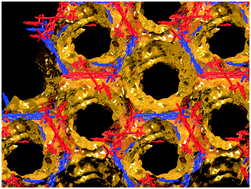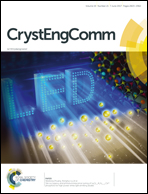What a difference a tail makes: 2D → 2D parallel interpenetration of sheets to interpenetrated nbo networks using ditopic-4,2′:6′,4′′-terpyridine ligands†
Abstract
Under conditions of crystal growth by layering at room temperature, 1,4-bis(n-hexoxy)-2,5-bis(4,2′:6′,4′′-terpyridin-4′-yl)benzene (4) or 1,4-bis(n-decoxy)-2,5-bis(4,2′:6′,4′′-terpyridin-4′-yl)benzene (5) reacts with ZnCl2 to yield [Zn2Cl4(4)]n or [Zn2Cl4(5)·2MeOH]n. The compounds crystallize in the C2/c space group with 2-dimensional (4,4) nets which interpenetrate in a 2D → 2D parallel manner. The ligands act as planar 4-connecting nodes linked through the zinc(II) centres. In contrast, 1,4-bis(3-phenylpropoxy)-2,5-bis(4,2′:6′,4′′-terpyridin-4′-yl)benzene (6) reacts with ZnBr2 to give [Zn2Br4(6)·H2O]n which crystallizes in the trigonal R![[3 with combining macron]](https://www.rsc.org/images/entities/char_0033_0304.gif) space group with a 3D assembly consisting of 2-fold interpenetrating nbo nets. Ligand 6 acts as a 4-connecting node and the zinc(II) centres are linkers. The pendant phenyl rings in 6 lie over the 4,2′:6′,4′′-tpy domains in an adjacent net and the resulting close association of the interpenetrated nets leads to a highly porous network.
space group with a 3D assembly consisting of 2-fold interpenetrating nbo nets. Ligand 6 acts as a 4-connecting node and the zinc(II) centres are linkers. The pendant phenyl rings in 6 lie over the 4,2′:6′,4′′-tpy domains in an adjacent net and the resulting close association of the interpenetrated nets leads to a highly porous network.



 Please wait while we load your content...
Please wait while we load your content...